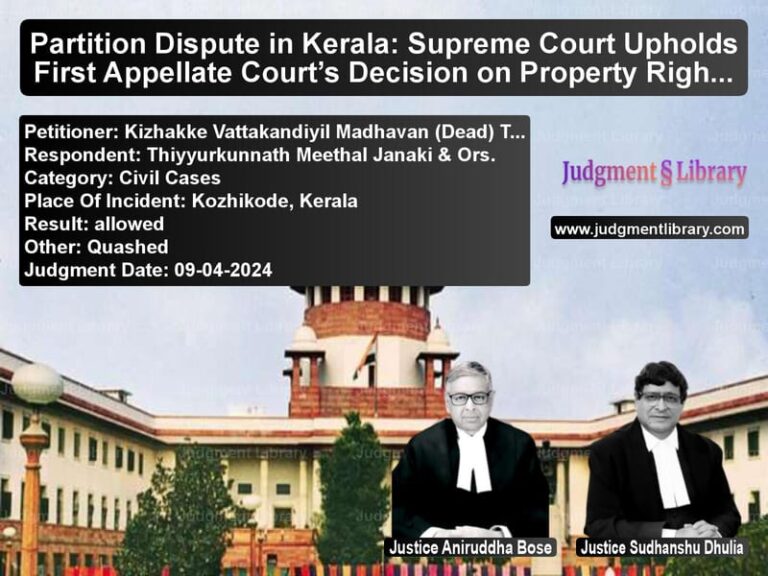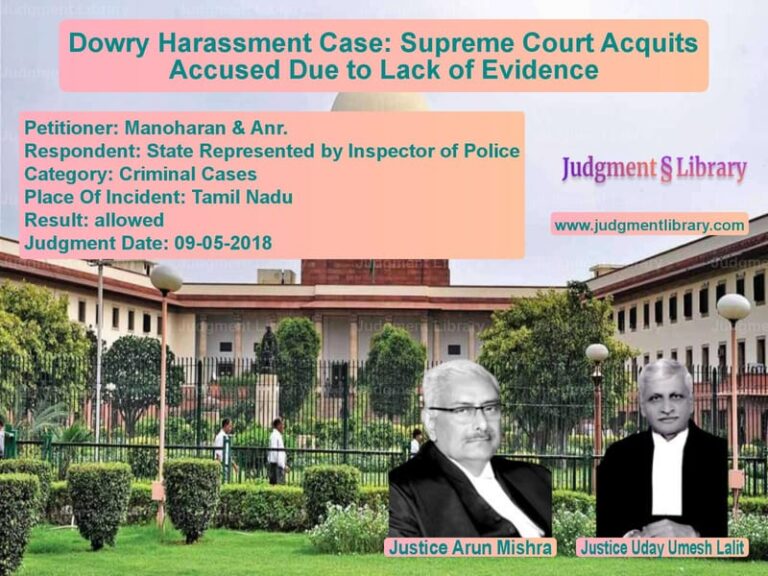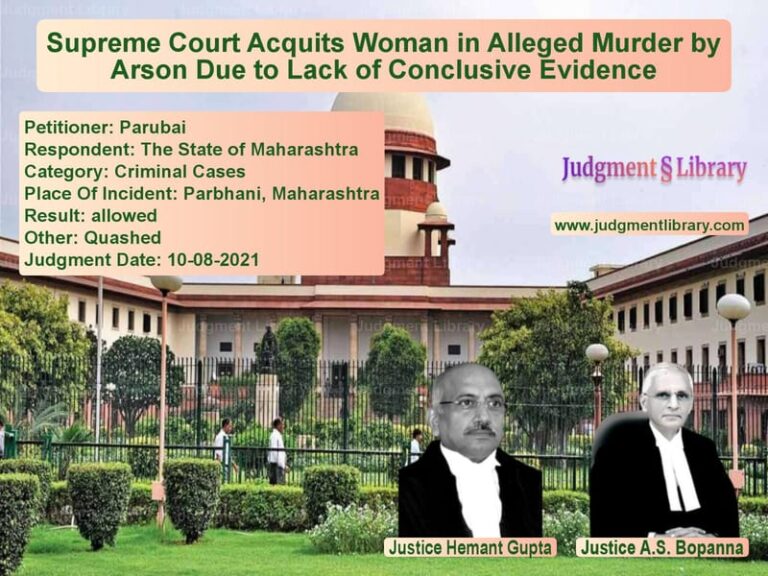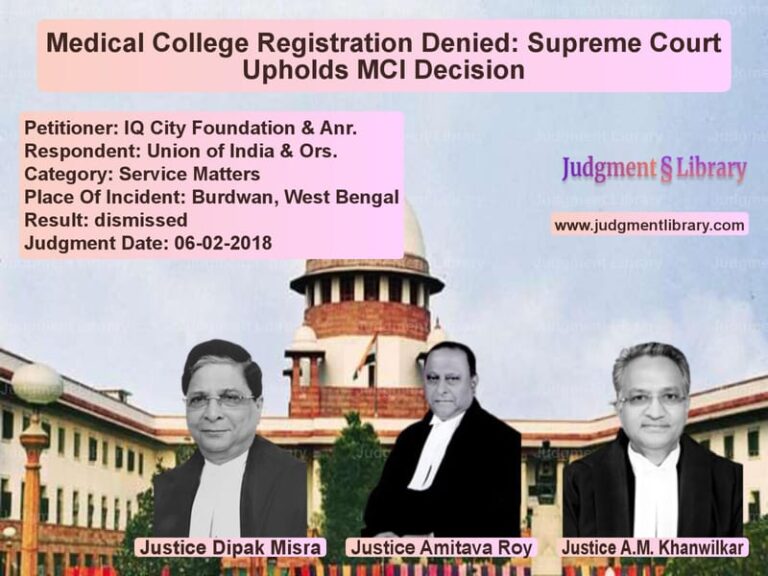Kidnapping and Murder Case: Supreme Court Upholds Conviction
The case of Munawwar v. State of Uttar Pradesh is a crucial criminal appeal addressing the conviction of the appellant for kidnapping and murdering a seven-year-old boy. The Supreme Court examined the evidence and upheld the conviction, emphasizing the importance of direct and circumstantial evidence in cases of abduction and homicide.
Background of the Case
The appellant, Munawwar, was convicted for the kidnapping and murder of a child, referred to as ‘X’, along with his brothers Noor Mohammad, Tahir (since deceased), and an accomplice, Shamim. The incident took place on April 1, 1988, in Muzaffarnagar, Uttar Pradesh, when the child went missing after being last seen with the accused. The prosecution relied on witness testimonies, ransom letters, and the discovery of the victim’s body to establish guilt beyond a reasonable doubt.
Arguments of the Parties
Petitioner’s (Appellant’s) Argument
- The appellant challenged the conviction on the basis that the principle of “last seen” had been wrongly invoked.
- The defense argued that even if witness testimonies were accepted, ‘X’ was last seen with multiple individuals, and there was a time gap between his disappearance and the discovery of his body.
- There was a delay in lodging the FIR, which should cast doubt on the prosecution’s case.
- The defense cited previous case laws, including Jaswant Gir v. State of Punjab and State of Goa v. Sanjay Thakran, arguing that mere last-seen evidence was insufficient for conviction.
Respondent’s (Prosecution’s) Argument
- The prosecution established that ‘X’ was kidnapped on April 1, 1988, and his body was recovered on April 18, 1988, based on a disclosure statement made by Noor Mohammad.
- Witnesses, including Mohd. Sayeed (PW-2), Ashraf (PW-3), Sayeed Ahmed (PW-5), and Mustak (PW-7), saw the victim in the company of the accused just before his disappearance.
- Ransom letters were received on April 3 and April 7, 1988, confirming that the child was abducted for extortion.
- Evidence suggested that the accused were maternal uncles of the victim and had a history of taking him out, which explains why the witnesses did not intervene.
Supreme Court’s Analysis
Evaluation of Evidence
The Court examined multiple witness statements and circumstantial evidence:
- Witness Testimonies: Multiple witnesses confirmed seeing ‘X’ with the accused on the day of the kidnapping.
- Ransom Letters: The first ransom note demanded Rs. 21,000, and a second note increased the demand to Rs. 22,000.
- Recovery of Body: Noor Mohammad’s disclosure led to the exhumation of the child’s body.
- Conduct of the Accused: Shamim was seen throwing a ransom letter into the victim’s house, confirming his involvement.
Principle of ‘Last Seen’
The Court distinguished this case from the cited precedents, stating:
“The present case would not in a strict sense be a case of mere ‘last seen’. ‘X’ was kidnapped at about 4:00 p.m. on April 1, 1988, when he was seen in the custody of the present appellant, Noor Mohammad, Tahir (since deceased), and Shamim. There was no time gap or interregnum between ‘X’s disappearance and kidnapping; they were simultaneous.”
The Court emphasized that the prosecution established a continuous sequence of events linking the accused to the crime.
Addressing the Delay in Filing FIR
The Court noted that the father delayed lodging an FIR due to fear for his son’s life and his attempts to arrange the ransom. This delay was reasonable and did not weaken the prosecution’s case.
Final Judgment
After considering all aspects, the Supreme Court dismissed the appeal and upheld the conviction under Sections 302 (murder), 365 (kidnapping), and 201 (causing disappearance of evidence) of the IPC.
“We do not find any merit in the present appeal and we affirm the judgment of the High Court accepting the judgment of the Additional Sessions Judge convicting the appellant-Munawwar under Sections 302, 365, and 201 read with Section 34 of the IPC. The appeal has no merit and is dismissed.”
Significance of the Judgment
This ruling sets a crucial precedent in cases of kidnapping and murder:
- Reiterates the validity of circumstantial and last-seen evidence when corroborated by other factors.
- Emphasizes the importance of examining the conduct of the accused post-crime.
- Clarifies that delays in FIR registration due to threats and extortion do not necessarily weaken a case.
Conclusion
The Supreme Court’s ruling in Munawwar v. State of Uttar Pradesh underscores the importance of a holistic view in criminal cases. It reinforces that justice is based on comprehensive evidence and that procedural delays do not automatically exonerate the accused. The decision is a landmark in the legal framework governing kidnapping and murder cases in India.
Petitioner Name: Munawwar.Respondent Name: State of Uttar Pradesh.Judgment By: Justice Indira Banerjee, Justice Sanjiv Khanna.Place Of Incident: Muzaffarnagar, Uttar Pradesh.Judgment Date: 16-07-2019.
Don’t miss out on the full details! Download the complete judgment in PDF format below and gain valuable insights instantly!
Download Judgment: Munawwar vs State of Uttar Prade Supreme Court of India Judgment Dated 16-07-2019.pdf
Direct Downlaod Judgment: Direct downlaod this Judgment
See all petitions in Murder Cases
See all petitions in Extortion and Blackmail
See all petitions in Judgment by Indira Banerjee
See all petitions in Judgment by Sanjiv Khanna
See all petitions in dismissed
See all petitions in supreme court of India judgments July 2019
See all petitions in 2019 judgments
See all posts in Criminal Cases Category
See all allowed petitions in Criminal Cases Category
See all Dismissed petitions in Criminal Cases Category
See all partially allowed petitions in Criminal Cases Category







